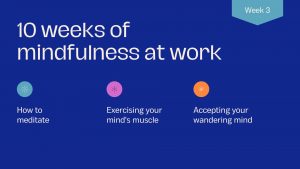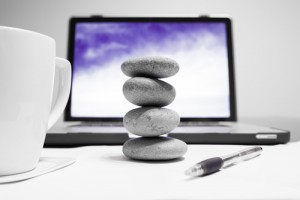10 Weeks of Mindfulness at Work
Welcome to week three of “10 Weeks of Mindfulness at Work” where you’ll discover simple tips and techniques to enrich your day with mindfulness. I hope you find inspiration from this 10-week series!
– How to Meditate
Meditation is a proven way to become mindful. To practice, set a timer for a few minutes and follow these simple steps for a short meditation break at work — or anywhere else you’d like!
Step #1. Sit up straight, without being rigid. Keep your spine aligned with your head and neck. Gently close your eyes. Try to release physical tension, keeping your body relaxed but your mind alert. (Note: see Week 2 of this series for tips on releasing physical tension.)
Step #2. Choose an anchor — a neutral object to focus on that doesn’t stimulate your mind. Examples of commonly used anchors are: your breath; the feeling of your body; a word repeated silently, such as “peace”; sounds, such as ocean waves; or an object to hold, such as a smooth stone.
Step #3. Rest your attention on your anchor. Every time your mind wanders, often each second or two for beginners, gently refocus on your anchor. Continue refocusing on your anchor for the rest of your practice time.
– Exercising Your Mind’s Muscle
Meditation is a practice of returning to your immediate experience in the present moment. Again and again and again. Notice when your attention wanders, and then return your attention to your anchor, as in Step #3 above.
This process is key to the practice of meditation, since it exercises your mind’s “muscle.” Just as the repetitive motion of abdominal crunches can build your core strength, the repetitive noticing and returning builds your power of awareness.
– Accepting Your Wandering Mind
Meditation isn’t a practice of stopping your thoughts. Thoughts will continue to arise, since it’s the nature of the mind to generate STUFF (an acronym I use for Stories, Thoughts, Urges, Frustrations and Feelings).
The intent of meditation isn’t to suppress thoughts and feelings. Consider anything that draws attention from your anchor to be like a cloud passing or like a boat floating by as you watch from the riverbank. Allow it to pass without judgment, and gently refocus on your anchor. The repetitive action of refocusing trains you to become mindful.
WEEK THREE PRACTICE SUGGESTION: Focus on just three breaths (or more if you’d like). Notice your chest or belly rising and falling — or the coolness of the air as you breathe in and its warmth as you breathe out. If your mind wanders, gently refocus on your breath, without judgment or internal comment.
**Celebrating a 10th Anniversary
Be on the lookout for a 99¢ Kindle promotion in July to celebrate the 10th anniversary of “Meditation Illuminated: Simple Ways to Manage Your Busy Mind,” a step-by-step book for beginning meditators. Available in Kindle, paperback and audiobook.


